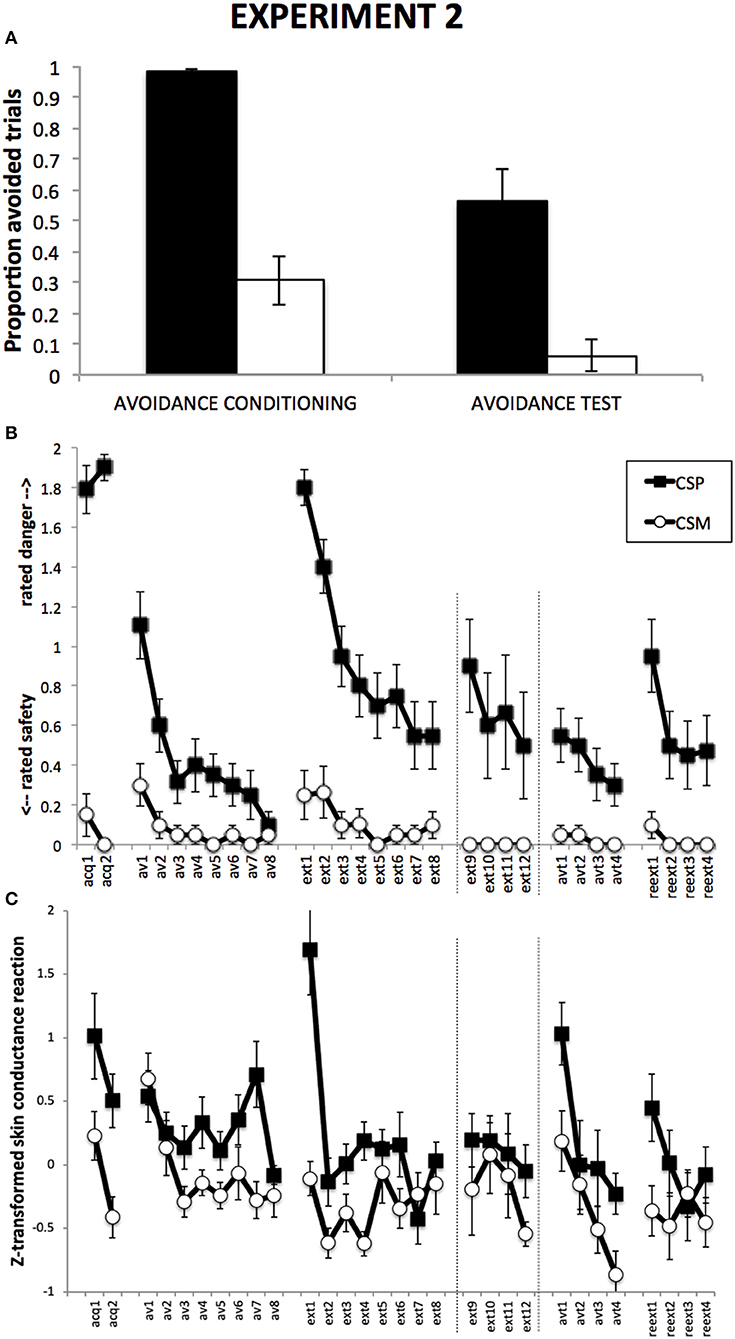
94% of researchers rate our articles as excellent or good
Learn more about the work of our research integrity team to safeguard the quality of each article we publish.
Find out more
CORRECTION article
Front. Behav. Neurosci., 25 February 2021
Sec. Learning and Memory
Volume 15 - 2021 | https://doi.org/10.3389/fnbeh.2021.656847
This article is a correction to:
Low-Cost Avoidance Behaviors are Resistant to Fear Extinction in Humans
A Corrigendum on
Low-Cost Avoidance Behaviors Are Resistant to Fear Extinction in Humans
by Vervliet, B., and Indekeu, E. (2015). Front. Behav. Neurosci. 9:351. doi: 10.3389/fnbeh.2015.00351
In the original article, there was a mistake in Figure 3 as published. Panel C of Figure 3 presented the skin conductance results of Experiment 1, instead of Experiment 2. The corrected Figure 3 appears below.

Figure 3. Results from Experiment 2. (A): Proportions of CSP and CSM trials during which the avoidance button was clicked, for avoidance conditioning and avoidance test phase separately. (B): Mean shock-expectancy ratings during CSP and CSM (0 = “safe,” 1 = “uncertain,” 2 = “danger”), for all trials of Pavlovian conditioning (acq1-2), avoidance conditioning (av1-8), response prevention and extinction (ext1-8) with extension for Group ExtLong between the dashed lines (ext9-12), avoidance test (avt1-4), and reextinction (reext1-4). (C): Z-transformed skin conductance reactions during CSP and CSM during all trials (cf. B). Error bars represent standard errors of the means.
The authors apologize for this error and state that this does not change the scientific conclusions of the article in any way. The original article has been updated.
Keywords: fear, extinction, avoidance, response prevention, exposure
Citation: Vervliet B and Indekeu E (2021) Corrigendum: Low-Cost Avoidance Behaviors are Resistant to Fear Extinction in Humans. Front. Behav. Neurosci. 15:656847. doi: 10.3389/fnbeh.2021.656847
Received: 21 January 2021; Accepted: 26 January 2021;
Published: 25 February 2021.
Edited and reviewed by: Denise Manahan-Vaughan, Ruhr University Bochum, Germany
Copyright © 2021 Vervliet and Indekeu. This is an open-access article distributed under the terms of the Creative Commons Attribution License (CC BY). The use, distribution or reproduction in other forums is permitted, provided the original author(s) and the copyright owner(s) are credited and that the original publication in this journal is cited, in accordance with accepted academic practice. No use, distribution or reproduction is permitted which does not comply with these terms.
*Correspondence: Bram Vervliet, YnJhbS52ZXJ2bGlldEBwcHcua3VsZXV2ZW4uYmU=
Disclaimer: All claims expressed in this article are solely those of the authors and do not necessarily represent those of their affiliated organizations, or those of the publisher, the editors and the reviewers. Any product that may be evaluated in this article or claim that may be made by its manufacturer is not guaranteed or endorsed by the publisher.
Research integrity at Frontiers

Learn more about the work of our research integrity team to safeguard the quality of each article we publish.